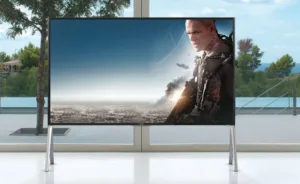Sony isn’t doing TVs at CES 2024. Instead, it flew consumer tech journalists to Tokyo to tout and promote its MiniLED LCD TV technology, expected later this year. In essence, Sony is upgrading the MiniLED dimming system in its high-end LCD TVs for 2024, with a focus on improving light control and efficiency.
The new MiniLED system will have more dimming zones than Sony’s previous flagship LCD TVs but the exact number is not disclosed. The new MiniLED driver is 22-bit (10-bit current + 12-bit PWM) and is claimed to be the world’s smallest. This enables more dimming zones to fit and improves efficiency – power consumption is reduced 10-15% overall and 30% in Eco mode compared to 2023 models. In demos, the 2024 prototype with the new MiniLED system showed better light control and detail than 2023 Sony MiniLED models and exceeded an OLED TV in very bright scenes.
The claims seem to be that the new tech is capable of reaching around 4,000 nits peak brightness, in the same range as Sony’s HX3110 professional mastering monitor and the new proprietary MiniLED driver chip developed by Sony, claimed to be the smallest in the industry, able to optimize LED current on a per-zone, per-frame basis for better efficiency. The system should have a wider color gamut from Sony’s Triluminos system
The general impact of the press tour couldn’t have gone better for Sony but, more interesting is the question of how this will impact OLED TV sales. It’s not just Sony that has gone big on unique MiniLED properties, there’s Hisense and TCL, too, who gotten traction with their approaches. There’s every likelihood that the end of 2024 is going to be a battle in the premium TV business, and that we are bound to see better pricing than we have in recent years. Good news for MiniLED LCD TVs and bad news for OLEDs? That remains to be seen. After all, Sony has been losing ground in the TV market for a while now, but could this be a comeback?
All we know for sure is that there are a lot of contradictions in the market: investment in LCD TVs has been diminishing, yet, the work being done on MiniLED LCD TVs suggests something else. We know that dimming zones matter, but is it the electronics behind them or is the sheer volume of zones? And, the TV purists are always going to shun the non-OLED as not being worthy of their positioning. Good thing consumers are the only people who get to actually vote and they have to put their money where their mouth is.

